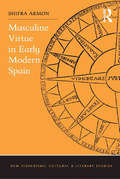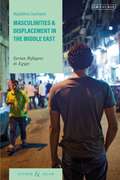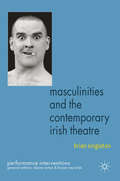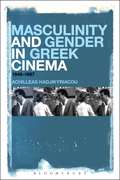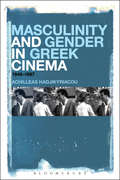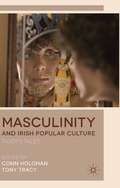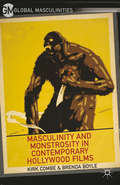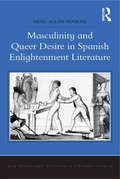- Table View
- List View
Masculine Virtue in Early Modern Spain (New Hispanisms: Cultural and Literary Studies)
by Shifra ArmonMasculine Virtue in Early Modern Spain extricates the history of masculinity in early modern Spain from the narrative of Spain’s fall from imperial power after 1640. This book culls genres as diverse as emblem books, poetry, drama, courtesy treatises and prose fiction, to restore the inception of courtiership at the Spanish Hapsburg court to the history of masculinity. Refuting the current conception that Spain’s political decline precipitated a ’crisis of masculinity’, Masculine Virtue maps changes in figurations of normative masculine conduct from 1500 to 1700. As Spain assumed the role of Europe’s first modern centralized empire, codes of masculine conduct changed to meet the demands of global rule. Viewed chronologically, Shifra Armon shows Spanish conduct literature to reveal three axes of transformation. The ideal subject (gendered male in both practice and law) became progressively more adaptable to changing circumstances, more intensely involved in currying his own public image, and more desirous of achieving renown. By bringing recent advances in gender theory to bear on normative rather than non-normative masculinities of early modern Spain, Armon is able to foreground the emergence of energizing new models of masculine virtue that continue to resonate today.
Masculine Virtue in Early Modern Spain (New Hispanisms: Cultural and Literary Studies)
by Shifra ArmonMasculine Virtue in Early Modern Spain extricates the history of masculinity in early modern Spain from the narrative of Spain’s fall from imperial power after 1640. This book culls genres as diverse as emblem books, poetry, drama, courtesy treatises and prose fiction, to restore the inception of courtiership at the Spanish Hapsburg court to the history of masculinity. Refuting the current conception that Spain’s political decline precipitated a ’crisis of masculinity’, Masculine Virtue maps changes in figurations of normative masculine conduct from 1500 to 1700. As Spain assumed the role of Europe’s first modern centralized empire, codes of masculine conduct changed to meet the demands of global rule. Viewed chronologically, Shifra Armon shows Spanish conduct literature to reveal three axes of transformation. The ideal subject (gendered male in both practice and law) became progressively more adaptable to changing circumstances, more intensely involved in currying his own public image, and more desirous of achieving renown. By bringing recent advances in gender theory to bear on normative rather than non-normative masculinities of early modern Spain, Armon is able to foreground the emergence of energizing new models of masculine virtue that continue to resonate today.
The Masculine Woman in Weimar Germany (Monographs in German History #32)
by Katie SuttonThroughout the Weimar period the so-called “masculinization of woman” was much more than merely an outsider or subcultural phenomenon; it was central to representations of the changing female ideal, and fed into wider debates concerning the health and fertility of the German “race” following the rupture of war. Drawing on recent developments within the history of sexuality, this book sheds new light on representations and discussions of the masculine woman within the Weimar print media from 1918–1933. It traces the connotations and controversies surrounding this figure from her rise to media prominence in the early 1920s until the beginning of the Nazi period, considering questions of race, class, sexuality, and geography. By focusing on styles, bodies and identities that did not conform to societal norms of binary gender or heterosexuality, this book contributes to our understanding of gendered lives and experiences at this pivotal juncture in German history.
Masculinities and Displacement in the Middle East: Syrian Refugees in Egypt (Gender and Islam)
by Magdalena SuerbaumFollowing the outbreak of the Syrian uprising in 2011, many Syrians fled to Egypt. This ethnographic study traces Syrian men's struggles in Cairo: their experiences in the Egyptian labour market and efforts to avoid unemployment; their ambitions to prove their 'groomability' in front of potential in-laws in order to get married; and their discontent with being assigned the label 'refugee'. The book reveals the strategies these men use to maintain their identity as the 'respectable Syrian middle-class man' - including engaging in processes of 'Othering' and the creation of hierarchies – and Magdalena Suerbaum explains why this proved so much more difficult for them after Morsi was toppled in 2013. Based on in-depth interviews, conversations and long-term participant observations, Suerbaum identifies Syrian men's emotional struggles as they undergo the experience of forced displacement and she highlights the adaptability and ultimate elasticity of constructed masculinities. The Syrians interviewed share their memories and their understandings of sectarianism and growing up in Syria, their interactions with the Egyptian and Syrian states, and their experiences during the Syrian uprising. The book takes an intersectional approach with close attention to the 'refugee' as a classed and gendered person.
Masculinities and Displacement in the Middle East: Syrian Refugees in Egypt (Gender and Islam)
by Magdalena SuerbaumFollowing the outbreak of the Syrian uprising in 2011, many Syrians fled to Egypt. This ethnographic study traces Syrian men's struggles in Cairo: their experiences in the Egyptian labour market and efforts to avoid unemployment; their ambitions to prove their 'groomability' in front of potential in-laws in order to get married; and their discontent with being assigned the label 'refugee'. The book reveals the strategies these men use to maintain their identity as the 'respectable Syrian middle-class man' - including engaging in processes of 'Othering' and the creation of hierarchies – and Magdalena Suerbaum explains why this proved so much more difficult for them after Morsi was toppled in 2013. Based on in-depth interviews, conversations and long-term participant observations, Suerbaum identifies Syrian men's emotional struggles as they undergo the experience of forced displacement and she highlights the adaptability and ultimate elasticity of constructed masculinities. The Syrians interviewed share their memories and their understandings of sectarianism and growing up in Syria, their interactions with the Egyptian and Syrian states, and their experiences during the Syrian uprising. The book takes an intersectional approach with close attention to the 'refugee' as a classed and gendered person.
Masculinities and the Contemporary Irish Theatre (Performance Interventions)
by B. SingletonIrish theatre and its histories appear to be dominated by men and their actions. This book's socially and culturally contextualized analysis of performance over the last two decades, however reveals masculinities that are anything but hegemonic, played out in theatres and other arenas of performance all over Ireland.
Masculinities in Contemporary Argentine Popular Cinema
by Carolina RochaExamines contemporary cinematic representations of Argentine masculinities, the social construction of gender, and the financing of domestic film production following Argentina's 1990 change to a neo-liberal economic model.
Masculinities in Polish, Czech and Slovak Cinema: Black Peters and Men of Marble
by Ewa MazierskaGender, especially masculinity, is a perspective rarely applied in discourses on cinema of Eastern/Central Europe. Masculinities in Polish, Czech and Slovak Cinema exposes an English-speaking audience to a large proportion of this region’s cinema that previously remained unknown, focusing on the relationship between representation of masculinity and nationality in the films of two and later three countries: Poland, Czechoslovakia/the Czech Republic and Slovakia. The objective of the book is to discuss the main types of men populating Polish, Czech and Slovak films: that of soldier, father, heterosexual and homosexual lover, against a rich political, social and cultural background. Czech, Slovak and Polish cinema appear to provide excellent material for comparison as they were produced in neighbouring countries which for over forty years endured a similar political system – state socialism.
Masculinities in the Court Tales of Daniel: Advancing Gender Studies in the Hebrew Bible (Routledge Studies in the Biblical World)
by Brian Charles DiPalmaIn this volume, Brian Charles DiPalma examines masculinities in the court tales of Daniel as a test case for issues facing the burgeoning area of gender studies in the Hebrew Bible. In doing so, it both analyses how the court tales of Daniel portray the characters in terms of configurations of masculinity in their socio-historical context, and also seeks to advance gender studies in the Hebrew Bible on theoretical, methodological, and political grounds. Masculinities in the Court Tales of Daniel is therefore of interest not only to scholars working on Daniel, but also biblical scholars studying gender in the Hebrew Bible more broadly, including those engaged in feminist criticism, queer criticism, and studies of masculinity, as well as anyone studying gender within an ancient Near Eastern context.
Masculinities in the Court Tales of Daniel: Advancing Gender Studies in the Hebrew Bible (Routledge Studies in the Biblical World)
by Brian Charles DiPalmaIn this volume, Brian Charles DiPalma examines masculinities in the court tales of Daniel as a test case for issues facing the burgeoning area of gender studies in the Hebrew Bible. In doing so, it both analyses how the court tales of Daniel portray the characters in terms of configurations of masculinity in their socio-historical context, and also seeks to advance gender studies in the Hebrew Bible on theoretical, methodological, and political grounds. Masculinities in the Court Tales of Daniel is therefore of interest not only to scholars working on Daniel, but also biblical scholars studying gender in the Hebrew Bible more broadly, including those engaged in feminist criticism, queer criticism, and studies of masculinity, as well as anyone studying gender within an ancient Near Eastern context.
Masculinities, militarisation and the End Conscription campaign: War resistance in apartheid South Africa
by Daniel ConwayExplores the gendered dynamics of apartheid-era South Africa's militarisation, analysing the defiance of compulsory military service and the anti-apartheid activism of the white men and women in the End Conscription Campaign.
Masculinity and Dress in Roman Antiquity (Routledge Monographs in Classical Studies)
by Kelly OlsonIn Masculinity and Dress in Roman Antiquity, Olson argues that clothing functioned as part of the process of communication by which elite male influence, masculinity, and sexuality were made known and acknowledged, and furthermore that these concepts interconnected in socially significant ways. This volume also sets out the details of masculine dress from literary and artistic evidence and the connection of clothing to rank, status, and ritual. This is the first monograph in English to draw together the myriad evidence for male dress in the Roman world, and examine it as evidence for men’s self-presentation, status, and social convention.
Masculinity and Dress in Roman Antiquity (Routledge Monographs in Classical Studies)
by Kelly OlsonIn Masculinity and Dress in Roman Antiquity, Olson argues that clothing functioned as part of the process of communication by which elite male influence, masculinity, and sexuality were made known and acknowledged, and furthermore that these concepts interconnected in socially significant ways. This volume also sets out the details of masculine dress from literary and artistic evidence and the connection of clothing to rank, status, and ritual. This is the first monograph in English to draw together the myriad evidence for male dress in the Roman world, and examine it as evidence for men’s self-presentation, status, and social convention.
Masculinity and Film Performance: Male Angst in Contemporary American Cinema
by D. PeberdyA lively and engaging study of on-screen and off-screen performances of masculinity, focusing on well-known male actors in American film and popular culture in the 1990s and 2000s. Peberdy examines specific social, cultural, historical and political contexts that have affected age, race, sexuality and fatherhood on screen.
Masculinity and Gender in Greek Cinema: 1949-1967
by Achilleas HadjikyriacouBetween the end of the Civil War (1949) and the colonels' military coup (1967) Greece underwent tremendous political, economic, and social transformations which influenced gender identities and relations. During the same period, Greece also witnessed an unparalleled bloom in cinema productions. Based on the recently established paradigm that cinema and popular culture viewed as social institutions can inform a historical study, Masculinity and Gender in Greek Cinema explores the relationship between Greek cinema and the society within which it was created and viewed. The book's double analytical perspective on cinema and masculinity advances both the study of cinema and popular culture as historical sources, and of masculinity and gender relations as valid categories of historical analysis. Cinema as a medium of representation, not only managed to reflect on these issues, it also provided a whole new field for their interpretation. This is the first study to explore the dramatic transformation of masculinity and gender roles, as represented in Greek cinema during the turbulent 1950s and 1960s.
Masculinity and Gender in Greek Cinema: 1949-1967
by Achilleas HadjikyriacouBetween the end of the Civil War (1949) and the colonels' military coup (1967) Greece underwent tremendous political, economic, and social transformations which influenced gender identities and relations. During the same period, Greece also witnessed an unparalleled bloom in cinema productions. Based on the recently established paradigm that cinema and popular culture viewed as social institutions can inform a historical study, Masculinity and Gender in Greek Cinema explores the relationship between Greek cinema and the society within which it was created and viewed. The book's double analytical perspective on cinema and masculinity advances both the study of cinema and popular culture as historical sources, and of masculinity and gender relations as valid categories of historical analysis. Cinema as a medium of representation, not only managed to reflect on these issues, it also provided a whole new field for their interpretation. This is the first study to explore the dramatic transformation of masculinity and gender roles, as represented in Greek cinema during the turbulent 1950s and 1960s.
Masculinity and Irish Popular Culture: Tiger's Tales
by Conn Holohan Tony TracyMasculinity and Irish Popular Culture: Tiger's Tales is an interdisciplinary collection of essays by established and emerging scholars, analysing the shifting representations of Irish men across a range of popular culture forms in the period of the Celtic Tiger and beyond.
Masculinity and Male Codes of Honor in Modern France (Studies in the History of Sexuality)
by Robert A. NyeGender studies have become an area of great interest in many disciplines. Here, Nye examines the evolving definitions of masculinity in France since the eighteenth century. Specifically, Nye looks at how the aristocratic ethos of male honor, rooted in a society of landlords, hunters, and warriors, adapted to a society motivated by utilitarian values, town life, and rational law. He focuses on the cultural practices and mentality of middle and upper class males and the appeal of their codes to men throughout French society.
Masculinity and Male Homosexuality in Britain, 1861-1913
by S. BradyThis book is part of a new generation of historical research that challenges prevailing arguments for the medical and legal construction of male homosexual identities in late nineteenth and early twentieth-century Britain. British society could not tolerate the discussion necessary to form medical or legal concepts of 'the homosexual'. The development of masculinity as a social status is examined, for its influence in shaping societal attitudes towards sex and sexuality between men and fostering resistance to any kind of recognition of these phenomena. Imperatives to bolster masculinity as a social status precluded public recognition of the existence of sex and sexuality between men, even in terms that were hostile and pejorative.
Masculinity and Monstrosity in Contemporary Hollywood Films (Global Masculinities)
by K. Combe B. BoyleIn film, Men are good and Monsters are bad. In this book, Combe and Boyle consider the monstrous body as a metaphor for the cultural body and regard gendered behavior as a matter of performativity. Taken together, these two identity positions, manliness and monsterliness, offer a window into the workings of current American society.
Masculinity and Nationhood, 1830-1910: Constructions of Identity and Citizenship in Belgium (Genders and Sexualities in History)
by J. HoegaertsA history of what it meant to be a man, and a citizen of an emerging nation throughout the nineteenth century. This book not only relates how Belgians were taught how to move and fight, but also how they spoke and sang to express masculinity and patriotism.
Masculinity and Power in Irish Nationalism, 1884-1938 (Genders and Sexualities in History)
by Aidan BeattyThis book is a comparative study of masculinity and white racial identity in Irish nationalism and Zionism. It analyses how both national movements sought to refute widespread anti-Irish or anti-Jewish stereotypes and create more prideful (and highly gendered) images of their respective nations. Drawing on English-, Irish-, and Hebrew-language archival sources, Aidan Beatty traces how male Irish nationalists sought to remake themselves as a proudly Gaelic-speaking race, rooted both in their national past as well as in the spaces and agricultural soil of Ireland. On the one hand, this was an attempt to refute contemporary British colonial notions that they were somehow a racially inferior or uncomfortably hybridised people. But this is also presented in the light of the general history of European nationalism; nationalist movements across Europe often crafted romanticised images of the nation’s past and Irish nationalism was thus simultaneously European and postcolonial. It is this that makes Irish nationalism similar to Zionism, a movement that sought to create a more idealized image of the Jewish past that would disprove contemporary anti-Semitic stereotypes.
Masculinity and Queer Desire in Spanish Enlightenment Literature (New Hispanisms: Cultural and Literary Studies)
by Mehl Allan PenroseIn Masculinity and Queer Desire in Spanish Enlightenment Literature, Mehl Allan Penrose examines three distinct male figures, each of which was represented as the Other in eighteenth- and early nineteenth-century Spanish literature. The most common configuration of non-normative men was the petimetre, an effeminate, Francophile male who figured a failed masculinity, a dubious sexuality, and an invasive French cultural presence. Also inscribed within cultural discourse were the bujarrón or ’sodomite,’ who participates in sexual relations with men, and the Arcadian shepherd, who expresses his desire for other males and who takes on agency as the voice of homoerotica. Analyzing journalistic essays, poetry, and drama, Penrose shows that Spanish authors employed queer images of men to engage debates about how males should appear, speak, and behave and whom they should love in order to be considered ’real’ Spaniards. Penrose interrogates works by a wide range of writers, including Luis Cañuelo, Ramón de la Cruz, and Félix MarÃa de Samaniego, arguing that the tropes created by these authors solidified the gender and sexual binary and defined and described what a ’queer’ man was in the Spanish collective imaginary. Masculinity and Queer Desire engages with current cultural, historical, and theoretical scholarship to propose the notion that the idea of queerness in gender and sexuality based on identifiable criteria started in Spain long before the medical concept of the ’homosexual’ was created around 1870.
Masculinity and Queer Desire in Spanish Enlightenment Literature (New Hispanisms: Cultural and Literary Studies)
by Mehl Allan PenroseIn Masculinity and Queer Desire in Spanish Enlightenment Literature, Mehl Allan Penrose examines three distinct male figures, each of which was represented as the Other in eighteenth- and early nineteenth-century Spanish literature. The most common configuration of non-normative men was the petimetre, an effeminate, Francophile male who figured a failed masculinity, a dubious sexuality, and an invasive French cultural presence. Also inscribed within cultural discourse were the bujarrón or ’sodomite,’ who participates in sexual relations with men, and the Arcadian shepherd, who expresses his desire for other males and who takes on agency as the voice of homoerotica. Analyzing journalistic essays, poetry, and drama, Penrose shows that Spanish authors employed queer images of men to engage debates about how males should appear, speak, and behave and whom they should love in order to be considered ’real’ Spaniards. Penrose interrogates works by a wide range of writers, including Luis Cañuelo, Ramón de la Cruz, and Félix MarÃa de Samaniego, arguing that the tropes created by these authors solidified the gender and sexual binary and defined and described what a ’queer’ man was in the Spanish collective imaginary. Masculinity and Queer Desire engages with current cultural, historical, and theoretical scholarship to propose the notion that the idea of queerness in gender and sexuality based on identifiable criteria started in Spain long before the medical concept of the ’homosexual’ was created around 1870.
Masculinity and Science in Britain, 1831–1918 (Genders and Sexualities in History)
by Heather EllisThis book offers the first in-depth study of the masculine self-fashioning of scientific practitioners in nineteenth and early twentieth-century Britain. Focusing on the British Association for the Advancement of Science, founded in 1831, it explores the complex and dynamic shifts in the public image of the British ‘man of science’ and questions the status of the natural scientist as a modern masculine hero. Until now, science has been examined by cultural historians primarily for evidence about the ways in which scientific discourses have shaped prevailing notions about women and supported the growth of oppressive patriarchal structures. This volume, by contrast, offers the first in-depth study of the importance of ideals of masculinity in the construction of the male scientist and British scientific culture in the nineteenth and early twentieth centuries. From the eighteenth-century identification of the natural philosopher with the reclusive scholar, to early nineteenth-century attempts to reinvent the scientist as a fashionable gentleman, to his subsequent reimagining as the epitome of Victorian moral earnestness and meritocracy, Heather Ellis analyzes the complex and changing public image of the British ‘man of science’.
